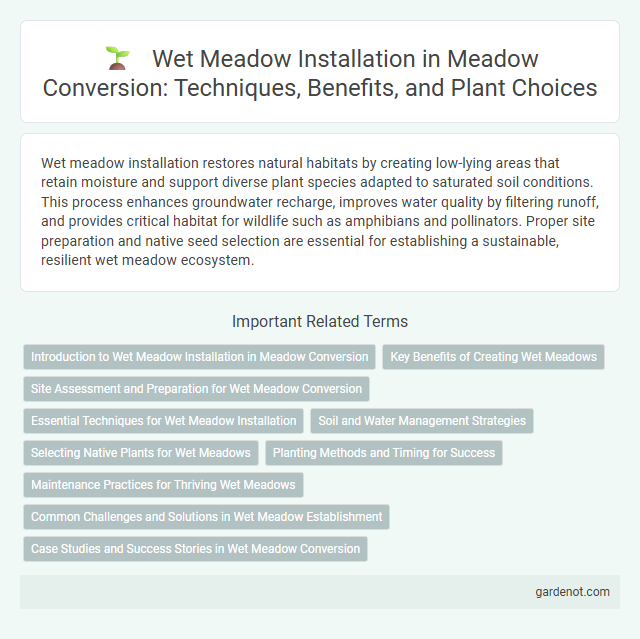Wet meadow installation restores natural habitats by creating low-lying areas that retain moisture and support diverse plant species adapted to saturated soil conditions. This process enhances groundwater recharge, improves water quality by filtering runoff, and provides critical habitat for wildlife such as amphibians and pollinators. Proper site preparation and native seed selection are essential for establishing a sustainable, resilient wet meadow ecosystem.
Introduction to Wet Meadow Installation in Meadow Conversion
Wet meadow installation in meadow conversion involves transforming low-lying, poorly drained areas into native wet meadow habitats that support diverse plant and animal species. This process includes soil preparation, selecting hydrophilic native grasses and wildflowers, and managing water levels to mimic natural wetland conditions. Effective wet meadow installation enhances biodiversity, improves water filtration, and provides crucial wildlife habitat.
Key Benefits of Creating Wet Meadows
Wet meadow installation enhances biodiversity by providing critical habitats for diverse wetland species and improving water filtration by naturally trapping sediments and pollutants. This sustainable land management practice supports flood mitigation through increased water retention and promotes carbon sequestration by preserving organic soil matter. Creating wet meadows also stabilizes soil, reducing erosion while enhancing the ecological resilience of surrounding landscapes.
Site Assessment and Preparation for Wet Meadow Conversion
Site assessment for wet meadow conversion involves thorough evaluation of soil moisture levels, hydrology, and existing vegetation to determine suitability and potential for restoration. Preparation includes grading adjustments to promote water retention, removal of invasive species, and soil amendments to enhance nutrient availability and support wetland plant establishment. Proper site preparation ensures optimal hydrological conditions necessary for sustainable wet meadow ecosystems.
Essential Techniques for Wet Meadow Installation
Successful wet meadow installation relies on precise soil moisture management, selecting native hydrophilic plant species, and creating microtopography to support water retention and diverse habitats. Proper site grading ensures consistent saturation, while seedbed preparation with minimal soil disturbance promotes optimal seed-to-soil contact. Incorporating a phased planting schedule aligned with seasonal hydrology enhances establishment and resilience of the wet meadow ecosystem.
Soil and Water Management Strategies
Effective wet meadow installation relies on precise soil and water management strategies to maintain optimal hydric conditions for native vegetation growth. Implementing controlled water retention techniques, such as shallow grading and engineered drainage systems, ensures consistent moisture levels, preventing soil erosion and nutrient runoff. Utilizing soil amendments and monitoring infiltration rates enhances soil structure and supports sustainable wet meadow ecosystems.
Selecting Native Plants for Wet Meadows
Selecting native plants for wet meadow installation enhances ecosystem resilience and supports local biodiversity by providing habitat for native wildlife. Key species include carex, blue flag iris, and swamp milkweed, which thrive in saturated soils and help stabilize the soil while improving water quality. Utilizing region-specific native plants reduces maintenance needs and ensures successful establishment in wet meadow restoration projects.
Planting Methods and Timing for Success
Successful wet meadow installation relies on precise planting methods and timing tailored to the local hydrology and seasonal cycles. Utilizing native wet meadow species, seed should be sown in late fall or early spring to capitalize on natural moisture and temperature conditions that enhance germination and establishment. Incorporating plug plants alongside seeding increases early site cover and resilience, promoting a sustainable wet meadow ecosystem.
Maintenance Practices for Thriving Wet Meadows
Regular monitoring of water levels ensures optimal hydrological conditions essential for wet meadow health. Controlling invasive species through targeted removal preserves native biodiversity and prevents habitat degradation. Implementing seasonal mowing or prescribed burning stimulates native plant growth and supports diverse wildlife populations.
Common Challenges and Solutions in Wet Meadow Establishment
Wet meadow installation often faces challenges including soil saturation variability, invasive species encroachment, and improper hydrology management that can hinder native plant establishment. Solutions involve precise site assessment for hydrological conditions, implementing adaptive water control structures, and proactive invasive species monitoring to promote native vegetation success. Regular maintenance and soil amendments improve soil aeration and nutrient balance, enhancing wet meadow resilience and biodiversity.
Case Studies and Success Stories in Wet Meadow Conversion
Wet meadow installation projects have demonstrated significant ecological and hydrological benefits, as evidenced by multiple case studies like the Chesapeake Bay restoration, where wet meadow conversion improved water quality by filtering runoff and providing habitat for diverse wildlife species. Success stories highlight how strategic planting of native wet meadow vegetation enhances biodiversity, supports pollinators, and stabilizes soil, reducing erosion and flood risks. These projects also showcase long-term resilience against climate variability, affirming wet meadow conversion as a sustainable land management practice.
Wet meadow installation Infographic

 gardenot.com
gardenot.com